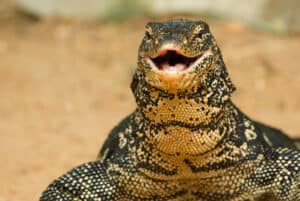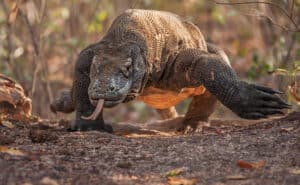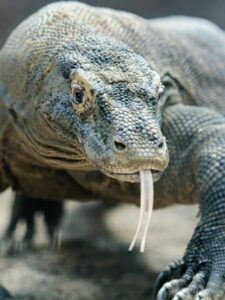Although iguanas are fairly challenging to keep as pets, many reptile enthusiasts enjoy housing and caring for these massive lizards. If you’re considering adopting a pet iguana of your own, you probably have a lot of questions about everything you need to know as far as their care requirements, the cost of keeping such a large reptile, how much time goes into their care, and more.
From food to enclosures to the cost of supplies, here’s everything you need to know about keeping an iguana as a pet. I’ll also cover what types of iguanas are commonly kept as pets and why certain species are more popular than others.
What Iguanas Can Be Kept As Pets?
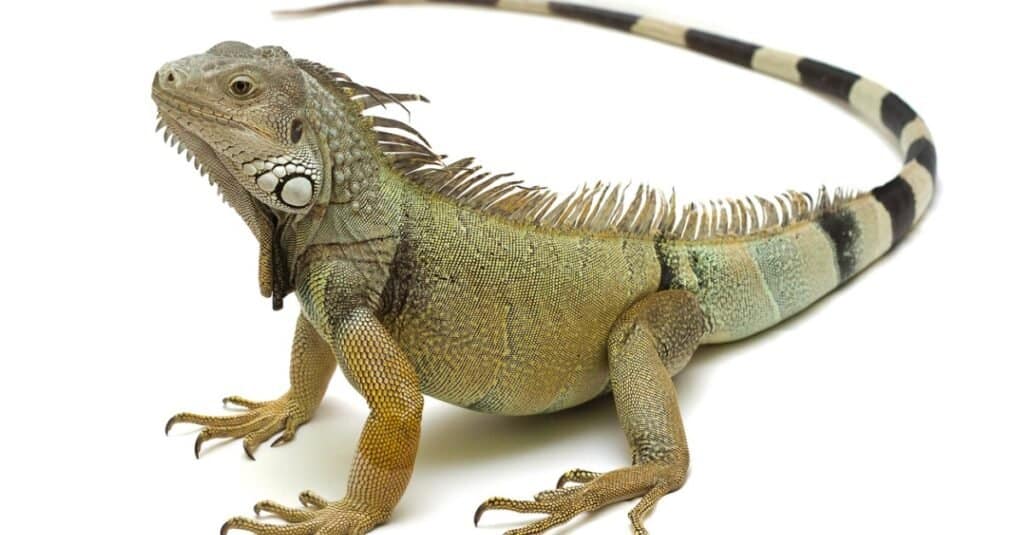
Green iguanas make excellent pets–if you’re up to the task of feeding and housing such a massive
lizard
!
©iStock.com/Che_Tina_Plant
There are roughly 40 total iguana species within the Iguanidae suborder, but only a handful make good pets. Some of the more popular species include:
- Green iguanas (and, by extension, their red and blue variations)
- Rhinoceros iguanas
- Desert iguanas
- Spiny-tailed iguanas
- Chuckwallas
Most iguana species haven’t been widely domesticated and typically aren’t available for purchase from reptile breeders. The above species, however, make good candidates as pets. This is because they have fairly docile temperaments and thrive well in captivity if all their needs are met.
Keep in mind, though, that all iguanas are large lizards that easily become several feet long as adults! Green iguanas, for example, often weigh as much as 15 to 20 pounds once they reach adulthood.
Because of their size, iguanas need a lot of space in captivity. Even the smallest of the aforementioned species, the desert iguana, grows to over 15 inches in length on average–and that’s not even counting its tail length!
What Do You Need For A Pet Iguana?
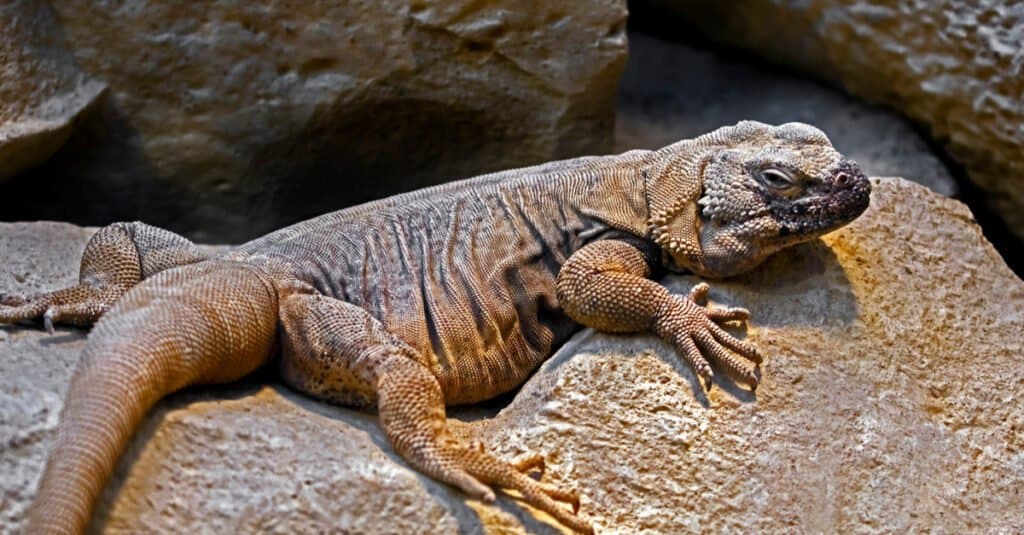
Iguanas like the chuckwalla
start off small as babies but become very large as adults!
©Mikhail Blajenov/Shutterstock.com
Let’s get into what you’ll need if you want to adopt and house one of these massive, majestic lizards. It is worth noting that all iguana species are not ideal for beginner reptile enthusiasts, young children, or anyone buying their very first pet reptile in general.
Many pet iguanas commonly get rehomed or abandoned by their owners within their first year of life, as they start out very small and manageable as babies but quickly explode in size. This makes these lizards difficult to handle, house, and feed long-term for anyone who hasn’t done their research in advance.
If you’re serious about adopting an iguana of your own but aren’t sure what you’ll need yet, here are the basics your new scaly friend will need to thrive in captivity:
- A VERY large enclosure. You won’t be able to place an iguana in a typical 20 to 60-gallon glass enclosure from a pet shop. This is fine for most baby iguanas, but within their first year of life, you’ll need to construct or custom-order an enclosure to suit them as they grow into their adult size. The minimum enclosure size for an adult green iguana, for example, should be at least 12 feet long, 6 feet wide, and 6 feet tall. It’s best to have a dedicated room in your home for the lizard’s habitat.
- Lighting/heating elements. Iguanas are cold-blooded and rely on their environments to regulate their body temperature. Because of this, their enclosures in captivity must also be properly heated at all times. This means you’ll be going through lots of large basking bulbs (as well as UVB lighting for most species). Keep in mind that these become quite costly over time.
- Cage decorations. Iguanas enjoy climbing in captivity, and all species need some kind of enrichment in their enclosures. You’ll need to place lots of branches, hides for shelter, sturdy platforms or ledges at various elevations, and lots of plants (ideally real, but for some species artificial plants are fine, too) throughout the enclosure to make it feel more natural and comfortable for your new pet.
- Substrate/bedding. Most iguana species spend most of their time climbing. However, their enclosures in captivity still require safe bedding to walk on. Avoid loose substrates with small, indigestible/non-biodegradable particles like wood chips/shavings or gravel. These often cause digestive impaction to iguanas if accidentally ingested. Some of the best inexpensive substrates include paper towels, tile, linoleum, and coconut fiber.
- Lots of food. Most iguana species are herbivorous and require a diet of primarily fresh greens, other vegetables, and fruits. A few popular species, like the rhinoceros iguana, are omnivorous and also eat various feeder insects. You can buy feeder insects from most reptile breeders or pet shops. This can also become costly, as most adult iguanas should eat at least one or two large meals each day!
- At least two dual thermometer/hygrometers. You will need to monitor your iguana’s enclosure closely to ensure the proper temperature and humidity settings. All species have slightly different requirements. In general, though, most iguanas need very warm and slightly humid enclosures to mimic the environment of their natural habitats. You should have at least two or three thermometer/hygrometers designed for reptile enclosures distributed throughout your iguana’s home so you can make adjustments as needed.
Keep in mind these are just the basics you’ll need for your iguana’s day-to-day care and housing. We’ll get into the approximate costs of these items as well as other necessities like veterinary care soon.
What Should You Feed A Pet Iguana?
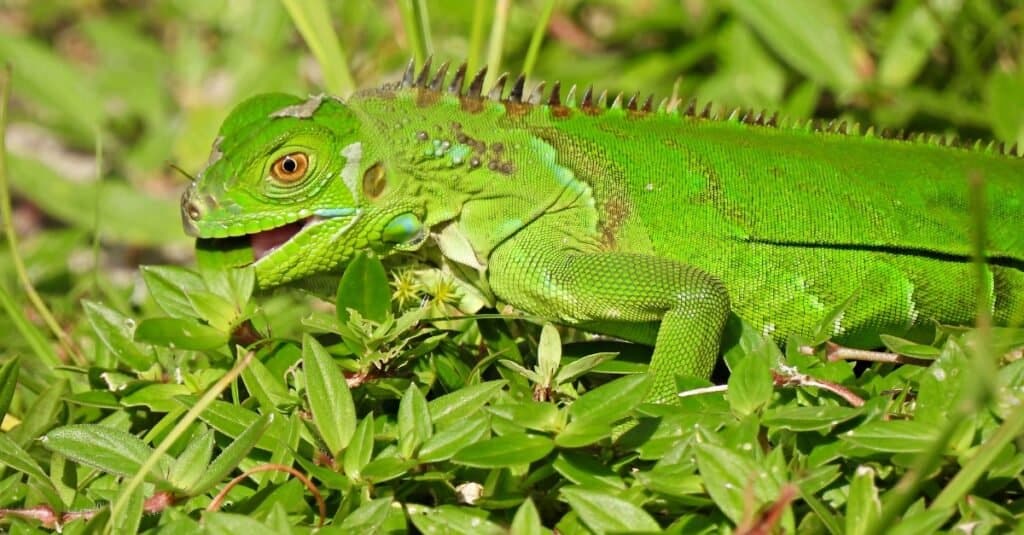
Most iguana species, such as the green iguana, are strict herbivores.
©iStock.com/passion4nature
The vast majority of iguana species are herbivorous, though a few, like the aforementioned rhinoceros iguana and spiny-tailed iguana, are omnivorous. This means you’ll need to provide your iguana with fresh greens, vegetables, and fruits on a daily basis. If you choose an omnivorous iguana, you’ll also need to provide them with live insects!
If the idea of feeding live bugs to your iguana makes you a bit queasy, don’t worry–most species are herbivorous! Opt for something like a green iguana or desert iguana, as they are strict vegetarians since their digestive tracts aren’t designed to break down animal protein.
Some of the foods most iguana species love eating regularly include:
- Dark, nutritious leafy greens. In most cases, this will make up the bulk of your iguana’s diet in captivity. Collard, turnip, and dandelion greens, for example, are all highly nutritious. These make an ideal base for most iguanas’ daily salads.
- Other safe, fresh vegetables. Another large chunk of an iguana’s diet should be made up of nutritious, delicious veggies. You have a lot to choose from here, and variety is key. Bell peppers, various types of squash, carrots, asparagus, and green beans are all great choices, as they are both healthy and tasty to most iguana species.
- A small amount of fresh fruit. Only around 15% of an iguana’s diet at most should be made up of fruit. This is because fruit is very sweet and high in oxalic acid. Oxalic acid can interfere with an iguana’s absorption of calcium and other minerals, so you’ll need to be careful with how much fruit you offer them. Most iguana species love eating fruit, as it is sweet and flavorful, sort of like candy for them, but moderation is essential for a healthy lizard.
- (Optional) Fresh feeder insects. This only applies if you’ve adopted one of the few omnivorous species like spiny-tailed or rhinoceros iguanas. Insects like superworms, dubia roaches, hornworns, and crickets are all good options. Be sure to buy them from a reputable seller that carefully breeds feeder insects in captivity rather than simply catching wild insects, as wild bugs often carry harmful diseases, parasites, and pesticides that are toxic to iguanas.
How Much Does A Pet Iguana Cost?
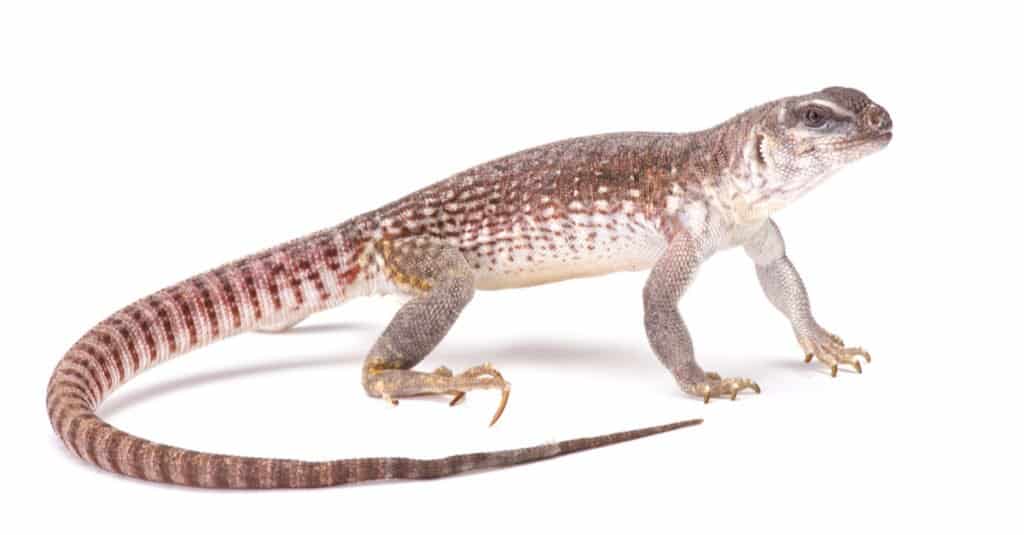
Desert iguanas are one of the smaller and less expensive iguana species.
©reptiles4all/Shutterstock.com
Finally, let’s go over the approximate cost of a typical pet iguana. This varies wildly, as there are many different species with their own care requirements. Still, we can at least make some estimates to give you an idea of whether or not owning one of these handsome lizards is realistic for your budget.
The first major cost that likely comes to mind is the iguana itself. Note that you shouldn’t be purchasing the iguana until you actually fully set up their enclosure and have purchased all their other necessary supplies. The best and most inexpensive means of acquiring a pet iguana is to purchase one from a reputable breeder.
Baby iguanas can cost anywhere from as little as $25 to $40 for a typical green iguana or desert iguana to $300+ for species like chuckwallas and rhinoceros iguanas. This is only the beginning of the expected expenses for your new pet, though! Keep reading to learn how much their enclosure setup and other care requirements cost monthly on average.
How Much Do Iguana Supplies Cost?
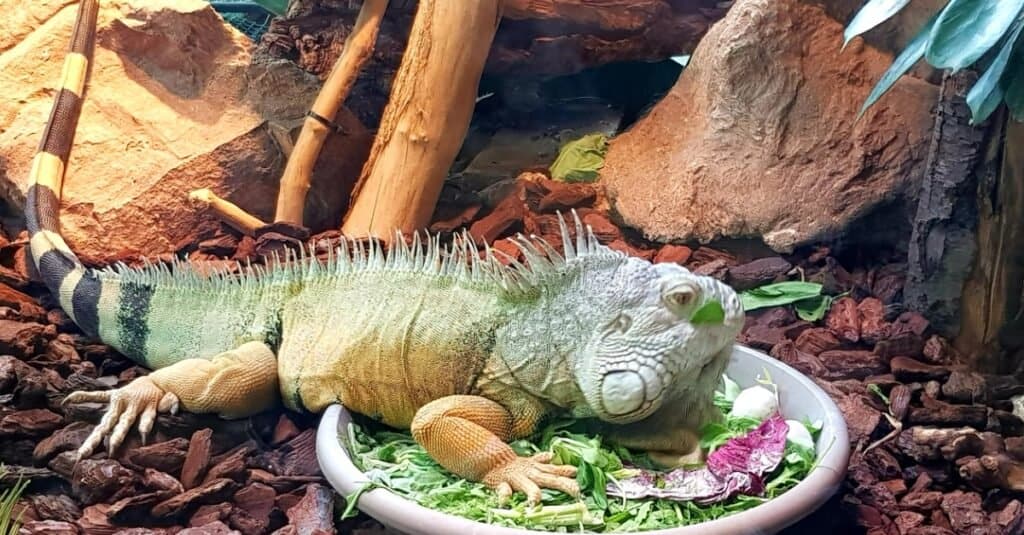
Green iguanas must eat a wide range of fresh fruits and vegetables in captivity.
©iStock.com/Suzana Dreno
The next major investment you’ll need to make for your iguana’s care is their enclosure. As I touched on earlier, you can either purchase an elaborate custom-made enclosure online for anywhere from $300 to $1,000 or more, or you can build one yourself for a lot less.
Again, you won’t be able to simply pick up a little glass tank from your local pet shop for an iguana, as they are far too large for these types of enclosures. Building an enclosure on your own can cost anywhere from $100 to $500+ for materials. The several hours or even days you’ll need to invest in building it is also an important factor to keep in mind.
For heating elements, expect to spend anywhere from $40 to $80+ initially on heat bulbs, fixtures to house the bulbs, and UVB bulbs if your iguana needs extra UV in captivity. From there, you’ll also need to buy new bulbs when they burn out, so there will also be a monthly, recurring cost of at least $30 to $50 or so.
As far as other enclosure decorations like branches, platforms, ladders, hammocks, food and water dishes, and plants, expect to spend anywhere from $50 to $150 or so initially. If you opt for live plants, you might need to replace them over time. The cost of these items varies significantly depending on the species of iguana you’ve selected. You may also need to replace certain items if your iguana breaks or damages them.
Next, you’ll need to factor in the cost of food. Each month, you can expect to spend at least $50 to $100 each month on fresh food for your iguana, whether it be fruits and vegetables or insects depending on their species.
Finally, be sure to keep at least $500 on hand at all times for vet visits. Your iguana should see a reptile vet at least once a year for a check-up. However, they may need additional veterinary care if they become sick or develop any health issues later in life.
The photo featured at the top of this post is © iStock.com/Suzana Dreno
Thank you for reading! Have some feedback for us? Contact the AZ Animals editorial team.



